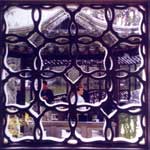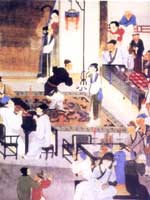
In the
Canglang Pavillion Garden of Suzhou, a winding path between Canglang
Pavillion and a covered corridor allows visitors to enjoy the views of
rockeries on the inside and water views through corridor's
windows. |
Suzhou, an ancient city in East China's Jiangsu Province, has again
attracted world attention, having been chosen as the host city for the 28th
session of the World Heritage Committee, which will be held from June 28 to July
7.
Popularly referred to as a "paradise on earth" in ancient times, Suzhou is
most famous for its classic gardens. Nine gardens in Suzhou are included on
UNESCO's World Cultural Heritage List. And Suzhou's Kunqu Opera was also classed
as a "Masterpiece of Oral and Intangible Cultural Heritage" by UNESCO in 2001.
But Suzhou has much more to offer than its beautiful gardens and marvelous
Kunqu Opera.
The fabric of the city's history is resplendent with its many strands of
local history and culture.
Suzhou people trace their history back to the end of the Shang Dynasty around
1100 BC. When Taibo, together with his brother Zhongyong, both princes of Zhou,
fled from China's northwest to the middle and lower reaches of the Yangtze
River, they were elected as leaders of the local people, laying the foundation
of the ancient Gou-Wu State.
That is why Suzhou was originally called Wu.
In 514 BC, Wu Zixu, the prime minister of King Helu, supervised the
re-construction of Suzhou, and that marked the beginning of today's city.
The city, at that time a town, was called Helu. It had a circumference of
23.5 kilometres, with walls and a moat and eight gates, traces of which can
still be found today.
Through its history, Suzhou has seen many changes, including its name. The
present name was adopted in AD 589 during the Sui Dynasty (AD 581-618). But it
has remained at the same site and retained its original construction for more
than 2,500 years.
With its grid structure of roads and waterways, ancient Suzhou used to be one
of the largest cities in China.
Records indicate that its main avenue was 45 metres wide, and its main canal
38 metres wide.
The Pingjiang Map, inscribed on a stone tablet that dates back to the Song
Dynasty (960-1279), preserved the layout of the then Suzhou in an accurate and
artistic way.

A square
window in a Suzhou garden turns the outside view into a
picture. |
On the map, city walls, government offices, markets, rivers, bridges,
Buddhist pagodas, temples, pavilions, granaries, military camps, towers, gardens
and lakes can all be identified.
Even scenic spots outside the city are included on the map. It might be the
world's earliest urban street map.
Comparing the map surveyed with remote sensors today with the Pingjiang Map,
it can be seen that Suzhou's layout at that time was essentially the same as it
is today.
The city is water-oriented, with the Yangtze River to its north, Taihu Lake
to the west and the Grand Canal going through it. Its broad network of waterways
greatly contributed to its development as an economic centre.
By the Jiaqing reign (1796-1820) of the Qing Dynasty (1644-1911), the
population in Suzhou had reached 6 million.
Silk-weaving

a painting
of a Kunqu Opera performance from the Qing Dynasty
(1644-1911). |
The imperial governments of the Ming and Qing dynasties (1368-1911)
established the Silk-Weaving Bureau in Suzhou to supervise the production of
textiles which were used by the imperial family and exported to foreign
countries as far away as Europe, Africa and the Americas.
Suzhou people also developed their own style of exquisite embroidery, which
is lauded as a "pearl of oriental art" for its beautiful designs, varied
stitches, superb workmanship and elegant colours.
Early in the Song Dynasty, Suzhou embroidery was already well known for its
delicate and close stitching and meticulous and wondrous use of colours.
In the Qing Dynasty, Suzhou embroidery reached a highpoint in its prosperity,
with embroidery markets flourishing throughout the city.
Centre of fashion
With the development of the local economy and the people's great cultural
accomplishment, Suzhou became one of the country's fashion leaders.
In the Ming and Qing dynasties, women nationwide followed closely the
dressing styles of the women of Suzhou.
The glamour of the soft-spoken local dialect attracted people to adopt a
Suzhou accent. Even as far back as the Sui Dynasty Emperor Suiyang used to
practise speaking the Suzhou dialect.
And the local ballads, featuring the sweetest melodies in all of China, were
widely circulated and sung.
The city was the nation's cultural centre as well, and generations of people
born in Suzhou have helped write the splendid history of the nation.
Kunqu and its legacy
Kunqu Opera is seen as one of the most splendid cultural creations of the
Chinese people.
With its roots in the folk songs of the mid 14th century, Kunqu Opera was
refined over a period of nearly 200 years to stand out prominently among all the
schools of opera in China. In 2001, UNESCO listed Kunqu as a "Masterpiece of
Oral and Intangible Cultural Heritage."
Kunqu Opera is a comprehensive performance art involving literature, music,
dance, acting, costumes, make-up, props and sets: namely, everything theatrical.
Its cultural heritage value is embodied in this comprehensive scope,
including its unique singing style. The subject matter for the operas comes from
a wide reservoir of resources, integrating all the refined performance
techniques and set tunes of northern and southern songs and operas of many
dynasties.
The huge library of scripts is another valuable treasure of Kunqu Opera. The
contents cover all periods of Chinese history. The most famous scripts currently
staged, include "Romance of the West Chamber" (Xixiang Ji) from the Yuan Dynasty
(1271-1368), "Peony Pavilion" (Mudan Ting) from the Ming Dynasty, and "Longevity
Hall" (Changsheng Dian) and "Peach Blossom Fan" (Taohua Shan) from the Qing
Dynasty.
Another feature of Kunqu Opera is its equal emphasis on singing and acting.
Centre of learning
During the Ming and Qing dynasties, Suzhou already had between 700 and 800
schools and dozens of academies.
These institutions of learning helped to nurture not only generations of
talented personages in all areas of life, but also a great number of zhuangyuan,
the people who got the top scores during exams held in the presence of the
emperor for administrative posts.
Throughout history, there have been 50 zhuangyuan from Suzhou, of whom, 45
were selected for their scholarship and five for their martial abilities.
Aside from zhuangyuan, there were more who have come down in history as great
masters of literature and the arts, although they didn't attend or win high
places in the imperial exams.
For example, the Wu school of painting and calligraphy of Suzhou is famous
nationwide. Its main representatives are Shen Zhou, Wen Zhengming, Tang Yin and
Qiu Ying of the Ming Dynasty (1368-1644).
This academic and artistic legacy has continued.
Local people are proud of the fact that 86 academicians of the Chinese
Academy of Science and Chinese Academy of Engineering come from Suzhou.
I. M. Pei, a world-celebrated master architect, Shi Min, famous
micro-electronics specialist, Wu Jianxiong, physicist, Nobel laureates Lee
Tsung-Dao and Steve Chu are all part of the pride of Suzhou.
For thousands of years, Suzhou people have used their wit and energy to keep
the city in the educational, artistic and cultural forefront.
Buddhism and Daoism reached the Wu area at the end of the Eastern Han Dynasty
(AD 25-220), and as a result, numerous temples have been built in and around the
city.
Traces of religion from the past are seen today in the ancient pagodas, most
of which have a very long history: The pagoda on Tiger Hill was built in AD 601
in the Sui Dynasty; Ruiguang pagoda was first built during the period of the
Three Kingdoms (AD 220-280) and rebuilt in the Northern Song Dynasty (AD
906-1127); Beisi pagoda was originally constructed in the Liang Dynasty (AD
502-557) and was repaired between 1078-1085; the Twins pagodas were first built
in 982; the Buddhist temple on Lingyan Mountain was originally built in the
Liang Dynasty and renovated in 1989.
Recently, a book entitled "Gateway to Suzhou" was published to provide a
thorough introduction to Suzhou for people attending the upcoming session of the
World Heritage Committee.
The book is a collaborative production of Suzhou Celebrity Studies of China
and the Culture and Art Publishing House. Experts in Kunqu Opera, ancient
architecture, and art and literature took part in its compilation. Famous
photographer Shao Hua contributed the pictures.
The book may well lead you to visit Suzhou to taste and feel the city's
unique cultural atmosphere first-hand.